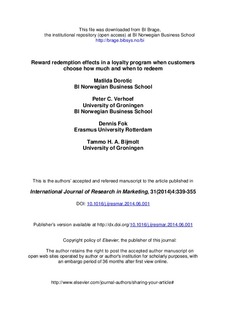Reward redemption effects in a loyalty program when customers choose how much and when to redeem
Journal article, Peer reviewed
Permanent lenke
http://hdl.handle.net/11250/278821Utgivelsesdato
2014Metadata
Vis full innførselSamlinger
- Scientific articles [2181]
Originalversjon
International Journal of Research in Marketing, 31(2014)4:339-355 10.1016/j.ijresmar.2014.06.001Sammendrag
The redemption of loyalty program (LP) rewards has an important impact on LP members’ behavior, particularly on purchase behavior before and after redeeming a reward. However, little is known about the interplay between members’ purchase and redemption behavior when members are not pressured with points expiration and they choose for themselves when and how much to redeem. In this context, the effects of redemption are not straightforward, as little additional effort is required from an LP member to obtain the reward. Analyzing the behavior of 3,094 members in such an LP, we find that the mere decision to redeem a reward significantly enhances purchase behavior before and after the redemption event, even when members redeem just a fraction of their accumulated points. Conceptually, we refer to this enhancement as the redemption momentum, which is an alternative and novel explanation of the existence of pre-reward effects that does not depend on points-pressure. In addition to the overall impact of redemption on purchases, prior purchase behavior also enhances redemption decisions. Finally, we find a number of moderating effects on purchase and redemption behavior that derive from the length of LP membership, age, income and direct mailings. Our study’s most important managerial implication is that firms can avoid imposing binding thresholds and/or points expiry and still enhance members’ purchase behavior.
Beskrivelse
This is the authors’ accepted and refereed manuscript to the article
